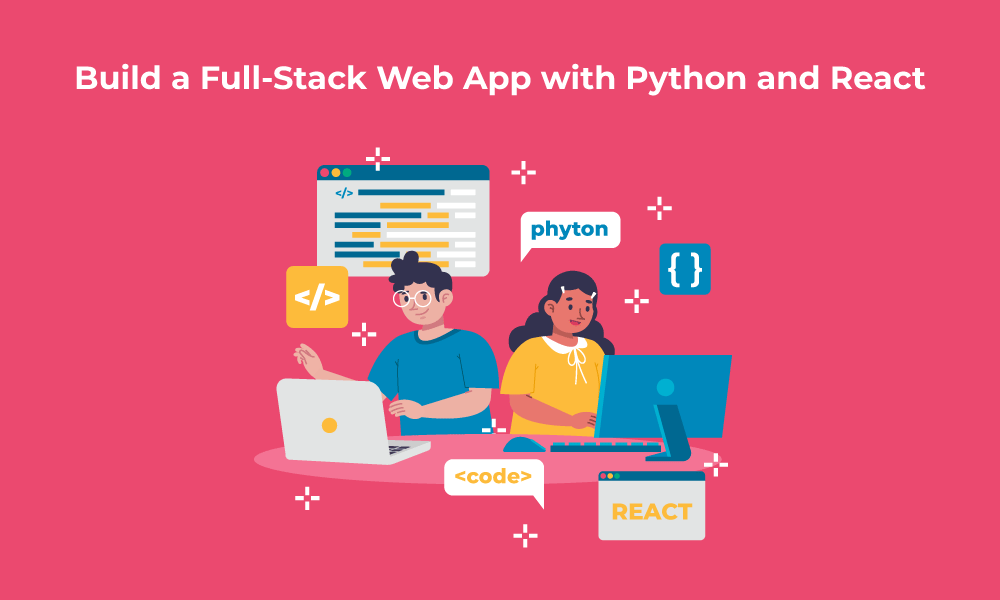- Python + React: Build a Full-Stack Web App with Python and React
- Python: Empowering Simplicity and Versatility in Programming
- React.js: Crafting Engaging and Dynamic User Interfaces
- Benefits of using Python with ReactJS
- Seamless Integration: Bridging the Backend and Frontend Effortlessly
- Diverse Skill Sets: Tapping into Both Technology Ecosystems
- Streamlined Development: Efficiency in Code Creation
- Enhanced User Experience: Creating Rich and Interactive Interfaces
- Data Handling and Processing: Python’s Robust Backend Support
- SEO-Friendly Applications: Optimizing for Search Engines
- Scalability and Performance: React.js for Dynamic UIs
- Comprehensive Testing: Ensuring Robust and Reliable Apps
- Why should we create Full-Stack Web App with Python and React
- Conclusion
Python + React: Build a Full-Stack Web App with Python and React
Python and React have evolved as a dynamic and strong mix in the ever-changing area of online development, allowing developers to create sophisticated and entertaining full-stack web projects. Python, known for its readability and simplicity, and React, a JavaScript toolset for developing user interfaces, collaborate to create powerful online programs. Python’s versatility and ease of use make it a suitable choice for backend development, but React’s component-based architecture facilitates frontend development by providing reusable, interactive UI elements.

Python: Empowering Simplicity and Versatility in Programming
Python is a programming language that is famous for standing specific and adaptable, and it contains a trustworthy reputation in the world of software development. Because it places a high priority on readability and utility, Python delivers developers a stable platform on which to recognize their ideas.
Python’s capabilities vary from web applications to data analysis, scientific computing to artificial intelligence, making it a great asset for programmers of all levels. Python’s relevance is centered on its simple and beautiful syntax. This approach not only speeds up development but also results in code that is extremely easy to read and maintain.
Python’s versatility extends beyond its syntax. Its vast collection of libraries and frameworks empowers developers to tackle diverse challenges with efficiency and precision. Whether you’re handling complex data manipulations, creating intuitive user interfaces, or orchestrating intricate algorithms, Python’s extensive ecosystem provides the tools needed to streamline development and create robust solutions.
Python’s flexibility across domains is another significant aspect. Using frameworks like Flask and Django, developers can create scalable and secure online applications, and libraries like NumPy and Pandas support advanced analytics and visualization in data science. The compatibility of Python with a range of platforms and operating systems ensures a consistent user experience in many contexts.
Moreover, Python’s focus on simplicity doesn’t compromise its power. Developers may create short yet expressive code to do complicated tasks, making it an excellent alternative for prototyping, scripting, and quick application development. Because of the combination of simplicity and efficiency, developers can iterate quickly and bring their visions to life with minimal effort.
Python’s impact reaches beyond its technical attributes. Its vibrant and welcoming community fosters a collaborative and inclusive environment where knowledge-sharing and learning thrive. The availability of online resources, tutorials, and documentation makes Python accessible to learners of all backgrounds, nurturing a diverse pool of developers who contribute to its continuous evolution.
React.js: Crafting Engaging and Dynamic User Interfaces
React is a JavaScript library that has transformed front-end web development. React, which is well-known for its ability to generate interactive and responsive user interfaces, enables developers to create modern online applications that capture and engage users in ways that were previously unthinkable.
The component-based architecture of React is essential to its significance. This innovative approach breaks down user interfaces into modular components, each encapsulating its logic and rendering. This modularity not only enhances code organization but also promotes reusability, allowing developers to efficiently create and maintain complex UI structures.
The virtual DOM (Document Object Model) is one of the most distinctive aspects of React. Unlike traditional DOM manipulation, where every change triggers a direct update, React’s virtual DOM optimizes performance by minimizing direct interaction with the actual DOM. Instead, React creates a virtual representation of the DOM and intelligently updates only the necessary elements when changes occur. As a result, rendering takes less time and the user experience is improved.
Additionally, React supports the idea of unidirectional data flow. This pattern ensures that data changes in an application follow a predictable path, making it easier to debug and maintain code. By maintaining a clear flow of data, React applications become more predictable and manageable, particularly as they grow in complexity.
Furthermore, React’s reactivity and real-time updates contribute to its interactive prowess. Developers can create dynamic user interfaces that respond instantaneously to user actions, providing a fluid and engaging experience. Whether it’s displaying real-time data, animating transitions, or handling user inputs, React’s ability to seamlessly update components sets the stage for captivating interactions.
React’s versatility extends beyond web development. With the introduction of React Native, developers can use their existing React abilities to create mobile applications for the iOS and Android platforms. This skill consolidation simplifies development and enables the construction of cross-platform applications with native-like performance and functionality.
React’s popularity is also amplified by its thriving ecosystem. The community-driven nature of React has given rise to a wealth of pre-built components, libraries, and tools that expedite development. From state management solutions like Redux to UI frameworks like Material-UI, React’s ecosystem empowers developers to create feature-rich applications efficiently.
Benefits of using Python with ReactJS
The advantages of combining Python and React.js are numerous and transformational. This dynamic combination enables developers to create visually appealing web apps that are also feature-rich, responsive, and efficient. The amalgamation of Python’s backend capabilities and React.js’s frontend interactivity opens doors to innovative possibilities, positioning developers to craft digital experiences that leave a lasting impact. As technology continues to evolve, the collaboration between Python and React.js will undoubtedly remain at the forefront of web development, inspiring the creation of remarkable applications that push the boundaries of user engagement and functionality.
Seamless Integration: Bridging the Backend and Frontend Effortlessly
One of the primary benefits of using Python with React.js is the seamless integration between backend and frontend development. Python’s capabilities shine on the backend, handling data processing, business logic, and database interactions. React.js excels at developing regaling and responsive front-end user interfaces. This connectivity provides a regular flow of data and real-time updates, resulting in an effortless user experience.
Diverse Skill Sets: Tapping into Both Technology Ecosystems
Utilizing Python and React.js together allows developers to tap into two robust technology ecosystems. Python’s numerous libraries and frameworks address a wide range of backend requirements, whereas React.js offers a diverse set of UI components and tools for front-end development. Developers with competence in either technology can effectively collaborate, combining their talents to create comprehensive and feature-rich apps.
Streamlined Development: Efficiency in Code Creation
Python’s clean syntax and React.js’s component-based architecture synergize to accelerate the development process. Developers can efficiently create modular and reusable components, resulting in code that is both elegant and easy to maintain. This streamlined approach reduces development time, enabling faster iterations and quicker time-to-market for innovative solutions.
Enhanced User Experience: Creating Rich and Interactive Interfaces
Python and React.js together unlock the potential for crafting enhanced user experiences. React.js’s ability to create dynamic and responsive interfaces aligns perfectly with Python’s backend capabilities. Real-time updates, smooth transitions, and interactive elements combine to engage users and keep them immersed in the application’s functionality.
Data Handling and Processing: Python’s Robust Backend Support
Python’s prowess in data handling and processing complements React.js’s frontend capabilities. Python’s extensive libraries for data analysis, manipulation, and machine learning can seamlessly integrate with React.js-powered interfaces. This integration enables developers to create data-driven applications that present information in a visually compelling and interactive manner.
SEO-Friendly Applications: Optimizing for Search Engines
Python’s backend efficiency contributes to creating SEO-friendly applications. Search engines favor fast-loading websites, and Python’s performance optimizations ensure that content is delivered swiftly. When combined with React.js’s efficient rendering and virtual DOM, applications become not only visually engaging but also search engine optimized.
Scalability and Performance: React.js for Dynamic UIs
React.js’s ability to handle dynamic user interfaces aligns with Python’s capacity for scalability. As applications grow, React.js facilitates the creation of interactive UIs without compromising performance. This scalability ensures that applications can handle increased traffic and user interactions without sacrificing responsiveness.
Comprehensive Testing: Ensuring Robust and Reliable Apps
The partnership between Python and React.js enhances the testing process. Python’s testing frameworks can be employed for backend testing, while React.js’s testing tools ensure frontend reliability. This comprehensive approach guarantees that applications are thoroughly tested and deliver a seamless experience to end users.
Why should we create Full-Stack Web App with Python and React
Creating a full-stack web app with Python and React is a strategic move that unlocks a realm of possibilities. Python and React are excellent choices for creating impactful and future-ready applications due to their smooth integration, improved user experience, versatility, and broad skill set. You have the skills to convert your thoughts into reality as you embark on this revolutionary adventure, leaving an unmistakable mark on the digital world.
Unmatched Versatility
Python and React combine to provide unmatched versatility, enabling developers to tackle a diverse range of challenges. Python’s extensive libraries cater to backend needs, from data manipulation to server management. UI components may be made modular and reusable thanks to React’s component-based architecture. This versatility empowers you to create a tailored solution that aligns with your application’s unique requirements.
Speed and Efficiency
The combination of Python and React accelerates development, resulting in streamlined processes and reduced time-to-market. Python’s clean syntax and React’s component-based structure facilitate efficient coding and modular development. This synergy enables you to bring your vision to life quickly and effectively.
Future-Proofing Your App
Building a full-stack web app with Python and React ensures that your application is prepared for the future. Python’s scalability and robustness handle increased traffic and data demands, while React’s dynamic front end enables the integration of new features and functionalities. This adaptability future-proofs your app, allowing it to evolve alongside changing user needs and technological advancements.
Empowering Creativity
Python and React empower developers to think creatively and innovate beyond boundaries. With a full-stack approach, you have the tools to create novel solutions, experiment with new technologies, and pioneer groundbreaking features. The synergy of Python and React serves as a canvas for turning your imaginative ideas into tangible realities.
Comprehensive Skill Set
Creating a full-stack web app with Python and React cultivates a comprehensive skill set. You become a full-stack maestro, proficient in both backend and frontend development. This proficiency not only enhances your versatility but also positions you as a valuable asset in a wide range of development projects.
Community and Resources
The Python and React communities are thriving hubs of knowledge sharing and collaboration. By building a full-stack web app with these technologies, you join a supportive ecosystem of developers, gaining access to a wealth of resources, tutorials, and frameworks. This community-driven environment propels your development journey forward.
Conclusion
The combination of Python and React offers a formidable route for developing full-stack online apps that smoothly blend robust functionality with a fascinating user experience in the dynamic arena of web development. You have armed yourself with the knowledge and resources to bring your unique ideas to life by embarking on this adventure. The path to mastery may be paved with obstacles, but it is via these obstacles that your talents will improve and your web development proficiency will flourish.







